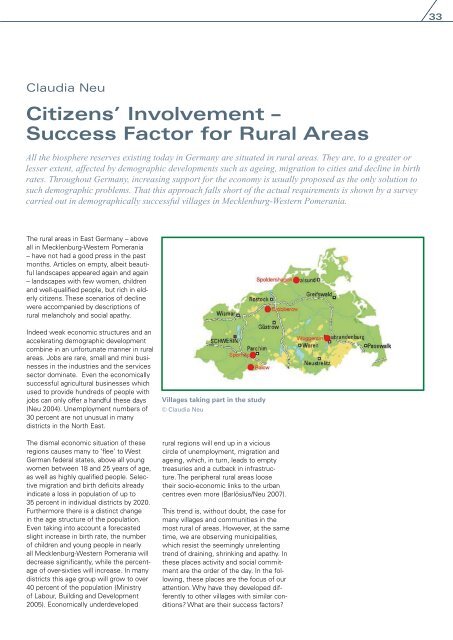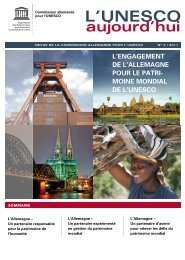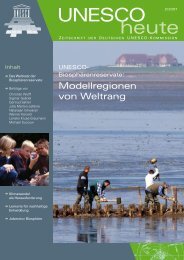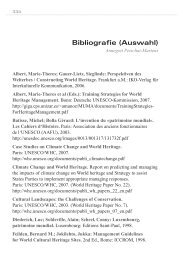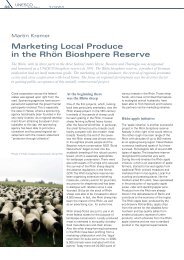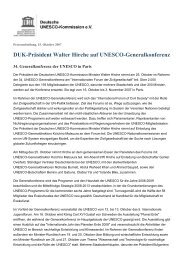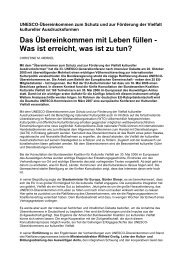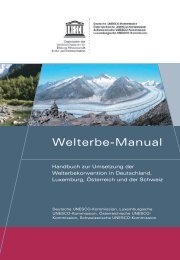Biosphere Reserves - UNESCO Deutschland
Biosphere Reserves - UNESCO Deutschland
Biosphere Reserves - UNESCO Deutschland
Create successful ePaper yourself
Turn your PDF publications into a flip-book with our unique Google optimized e-Paper software.
Claudia Neu<br />
Citizens’ Involvement –<br />
Success Factor for Rural Areas<br />
All the biosphere reserves existing today in Germany are situated in rural areas. They are, to a greater or<br />
lesser extent, affected by demographic developments such as ageing, migration to cities and decline in birth<br />
rates. Throughout Germany, increasing support for the economy is usually proposed as the only solution to<br />
such demographic problems. That this approach falls short of the actual requirements is shown by a survey<br />
carried out in demographically successful villages in Mecklenburg-Western Pomerania.<br />
The rural areas in East Germany – above<br />
all in Mecklenburg-Western Pomerania<br />
– have not had a good press in the past<br />
months. Articles on empty, albeit beautiful<br />
landscapes appeared again and again<br />
– landscapes with few women, children<br />
and well-qualified people, but rich in elderly<br />
citizens. These scenarios of decline<br />
were accompanied by descriptions of<br />
rural melancholy and social apathy.<br />
Indeed weak economic structures and an<br />
accelerating demographic development<br />
combine in an unfortunate manner in rural<br />
areas. Jobs are rare, small and mini businesses<br />
in the industries and the services<br />
sector dominate. Even the economically<br />
successful agricultural businesses which<br />
used to provide hundreds of people with<br />
jobs can only offer a handful these days<br />
(Neu 2004). Unemployment numbers of<br />
30 percent are not unusual in many<br />
districts in the North East.<br />
The dismal economic situation of these<br />
regions causes many to ‘flee’ to West<br />
German federal states, above all young<br />
women between 18 and 25 years of age,<br />
as well as highly qualified people. Selective<br />
migration and birth deficits already<br />
indicate a loss in population of up to<br />
35 percent in individual districts by 2020.<br />
Furthermore there is a distinct change<br />
in the age structure of the population.<br />
Even taking into account a forecasted<br />
slight increase in birth rate, the number<br />
of children and young people in nearly<br />
all Mecklenburg-Western Pomerania will<br />
decrease significantly, while the percentage<br />
of over-sixties will increase. In many<br />
districts this age group will grow to over<br />
40 percent of the population (Ministry<br />
of Labour, Building and Development<br />
2005). Economically underdeveloped<br />
Villages taking part in the study<br />
© Claudia Neu<br />
rural regions will end up in a vicious<br />
circle of unemployment, migration and<br />
ageing, which, in turn, leads to empty<br />
treasuries and a cutback in infrastructure.<br />
The peripheral rural areas loose<br />
their socio-economic links to the urban<br />
centres even more (Barlösius/Neu 2007).<br />
This trend is, without doubt, the case for<br />
many villages and communities in the<br />
most rural of areas. However, at the same<br />
time, we are observing municipalities,<br />
which resist the seemingly unrelenting<br />
trend of draining, shrinking and apathy. In<br />
these places activity and social commitment<br />
are the order of the day. In the following,<br />
these places are the focus of our<br />
attention. Why have they developed differently<br />
to other villages with similar conditions?<br />
What are their success factors?


